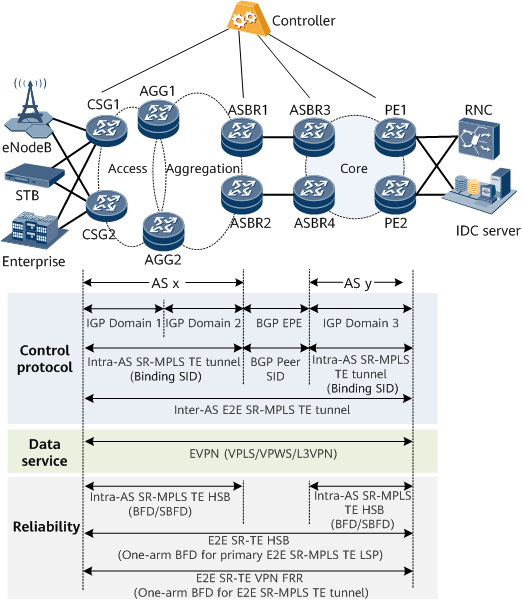Inter-AS E2E SR-MPLS TE
Service Overview
Future networks will be 5G oriented. Transport networks need to be adjusted to meet 5G requirements for network simplification, low latency, and SDN and network functions virtualization (NFV) implementation. E2E SR-MPLS TE can carry VPN services through a complete inter-AS tunnel, which greatly reduces networking and O&M costs and meets carriers' requirement for unified O&M.
Networking Description
Figure 1 illustrates the typical application of inter-AS E2E SR-MPLS TE on a transport network. The overall service model of the network is EVPN over SR-MPLS TE, with an E2E SR-MPLS TE tunnel as the transmission channel and EVPN as the data service model. Being oriented to 5G, this network features simplified solutions, protocols, and tunnels, as well as unified reliability solutions. With the help of a network controller, this network can quickly respond to upper-layer service requirements.
Service Deployment
Configure IGP SR within ASs, establish intra-AS SR-MPLS TE tunnels, and configure BGP EPE between ASs to allocate inter-AS SIDs. In addition, use technologies, such as the binding SID technology, to combine multiple intra-AS SR-MPLS TE tunnels into an inter-AS E2E SR-MPLS TE tunnel.
Deploy EVPN to carry various services, including EVPN VPWS, EVPN VPLS, and EVPN L3VPN. Besides EVPN services, traditional BGP L3VPN services can also be smoothly switched to E2E SR-MPLS TE tunnels for transmission.
In terms of reliability, for intra-AS SR-MPLS TE tunnels, deploy BFD/SBFD to detect faults and TE hot-standby (HSB) to switch traffic between primary and backup TE LSPs; for inter-AS E2E SR-MPLS TE tunnels, deploy one-arm BFD to detect faults, TE HSB to switch traffic between primary and backup TE LSPs, and VPN FRR to switch traffic between primary and backup E2E SR-MPLS TE tunnels.
